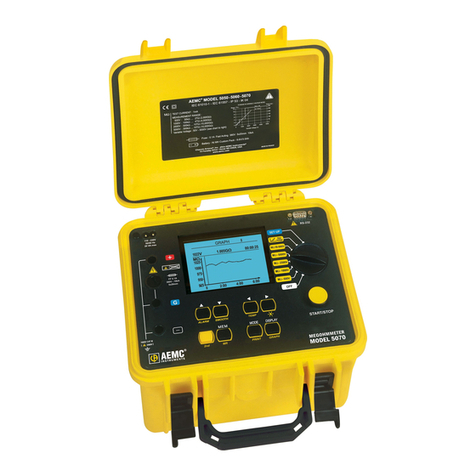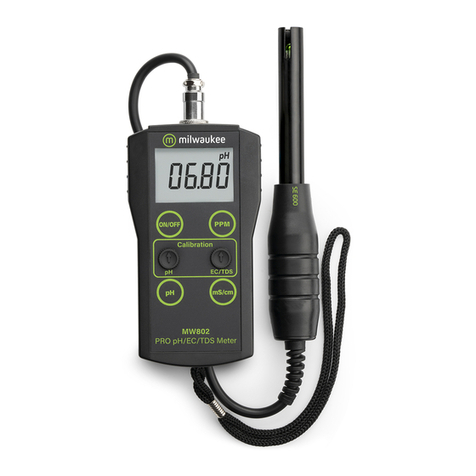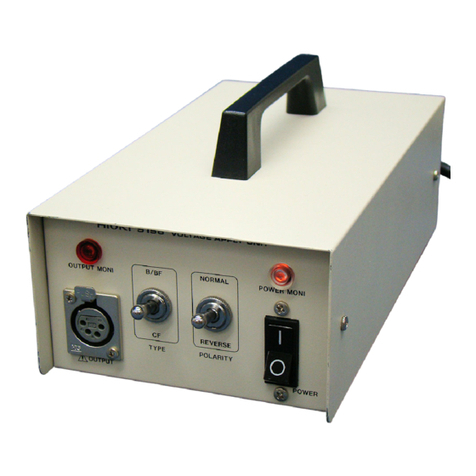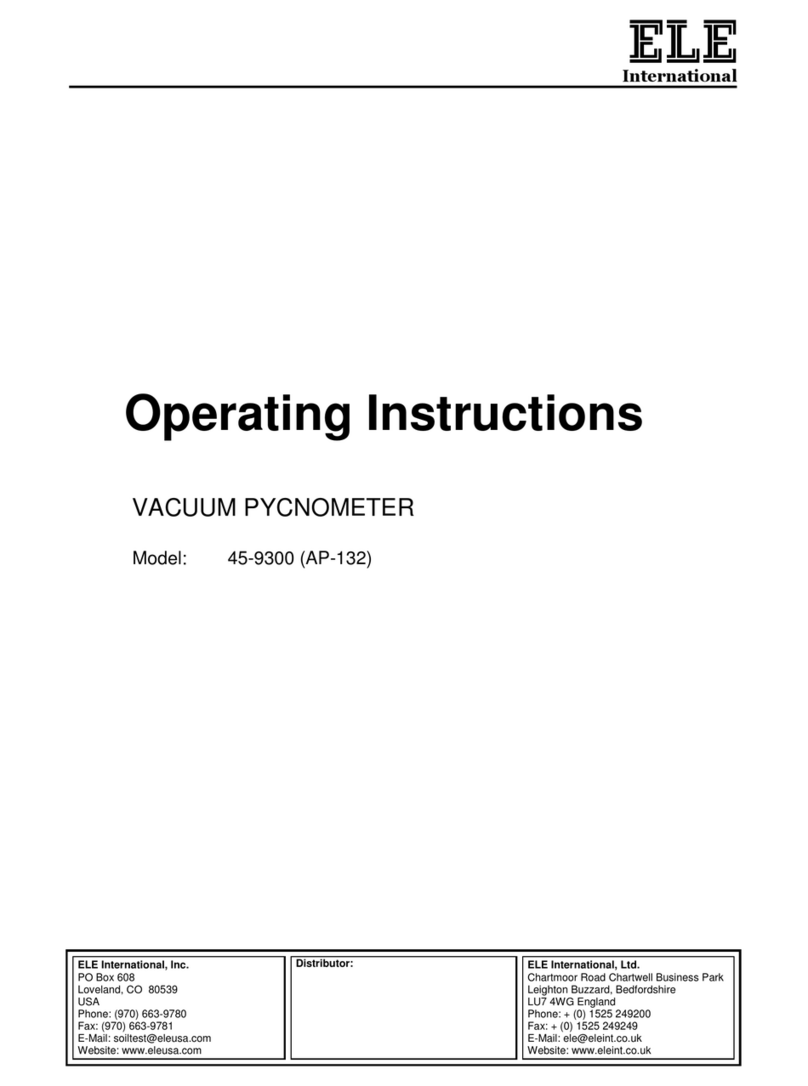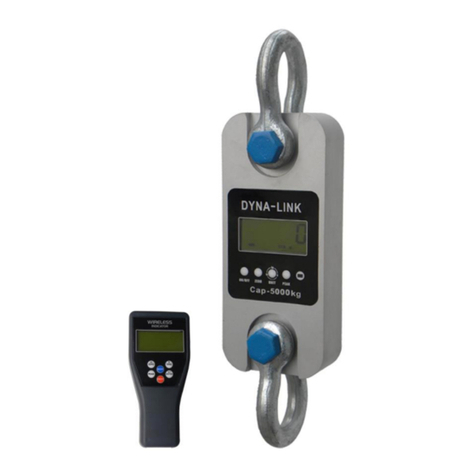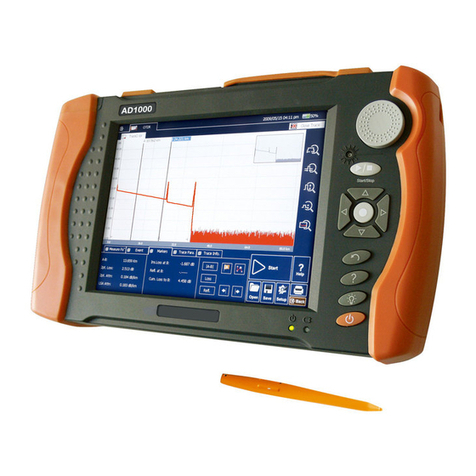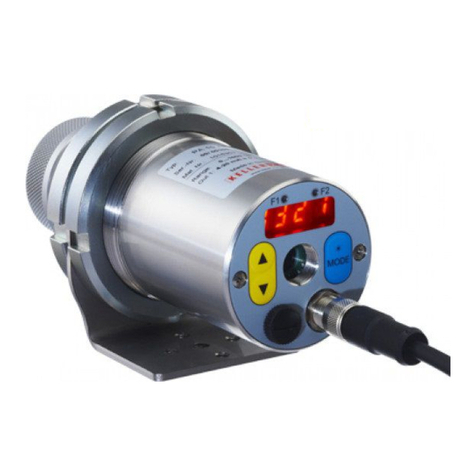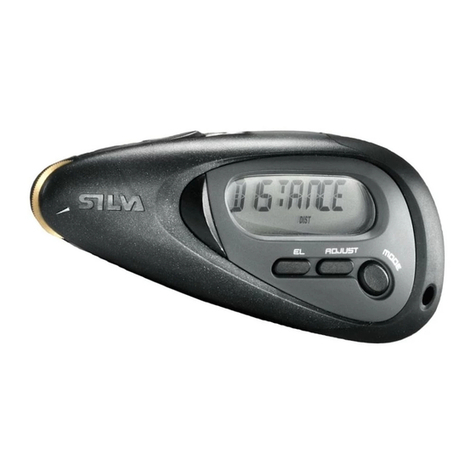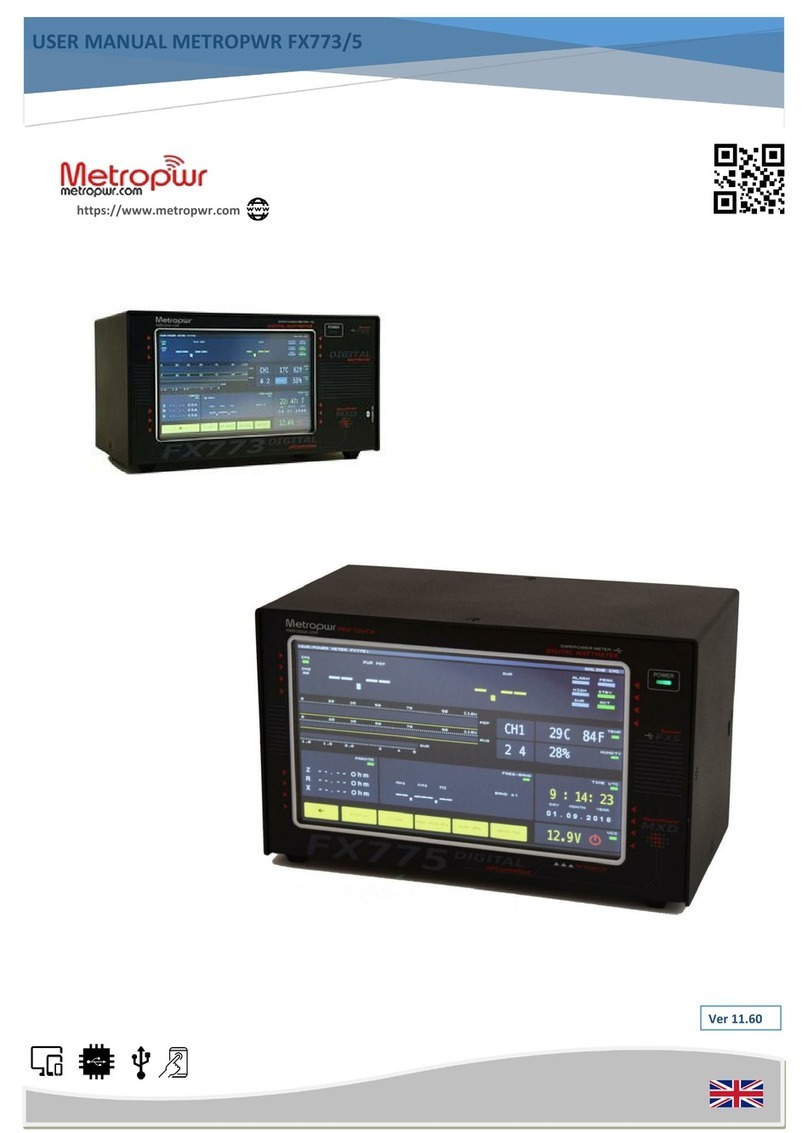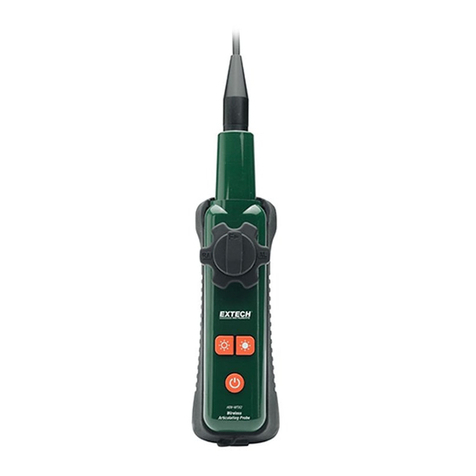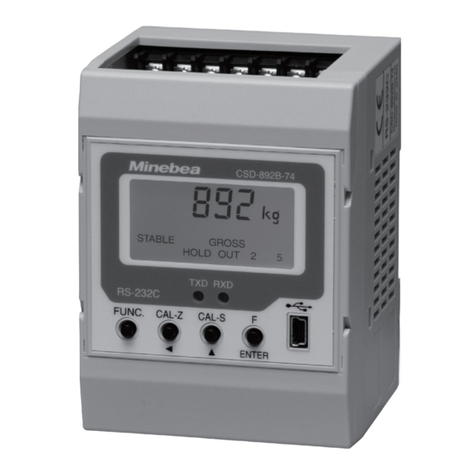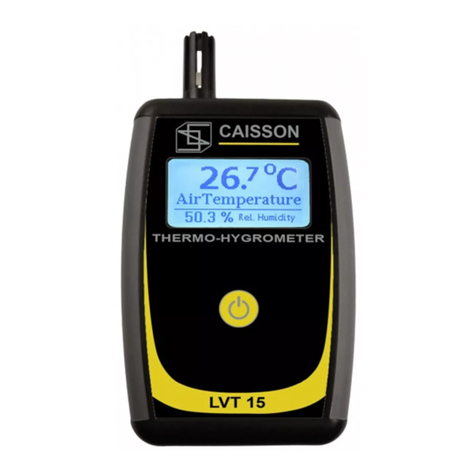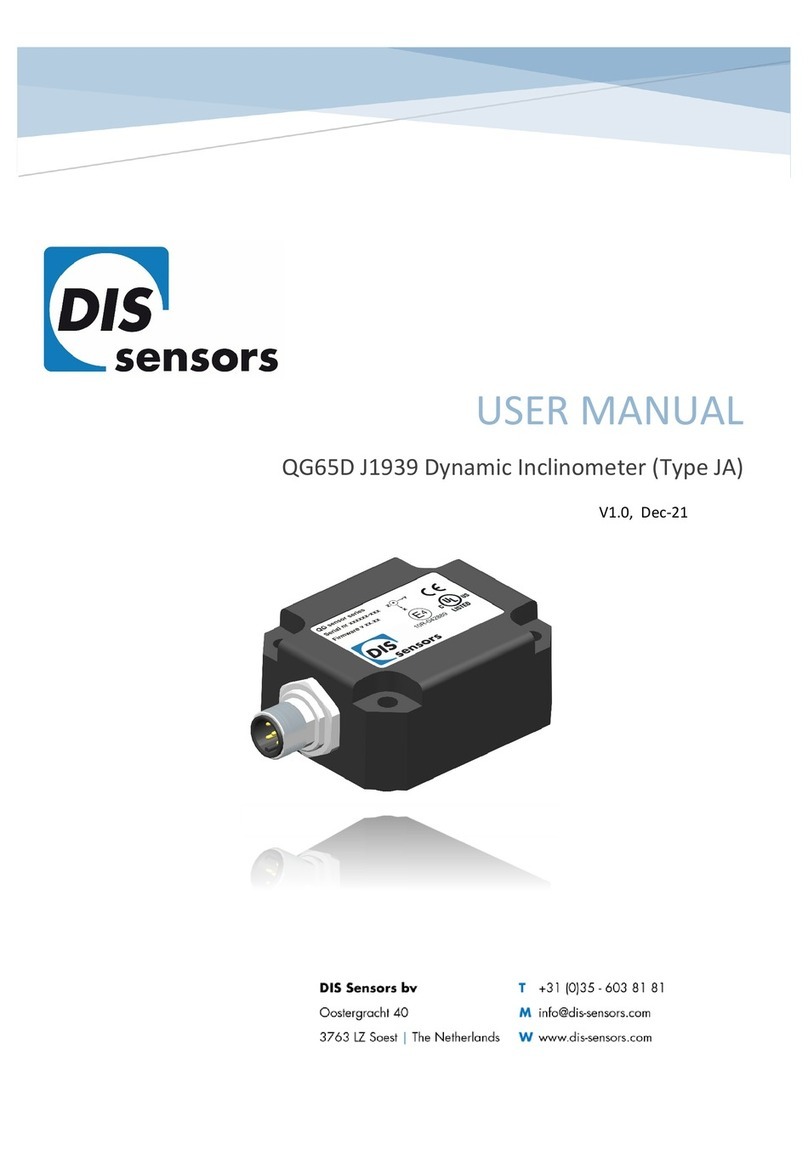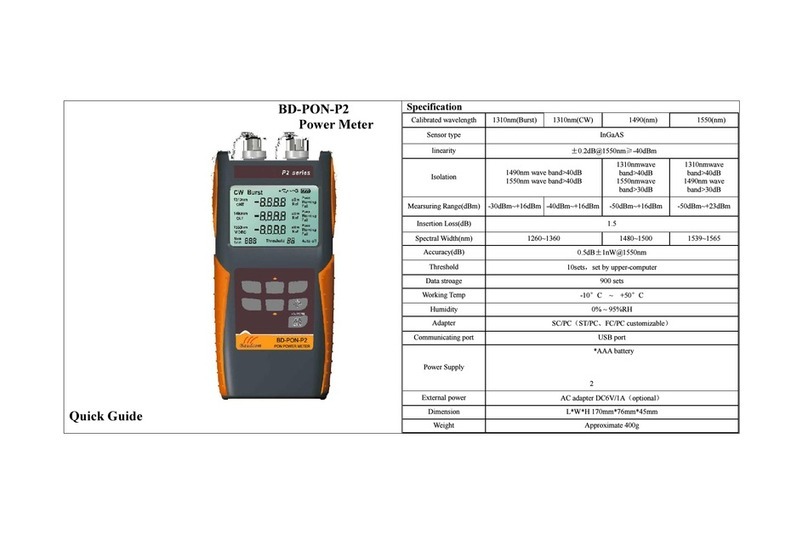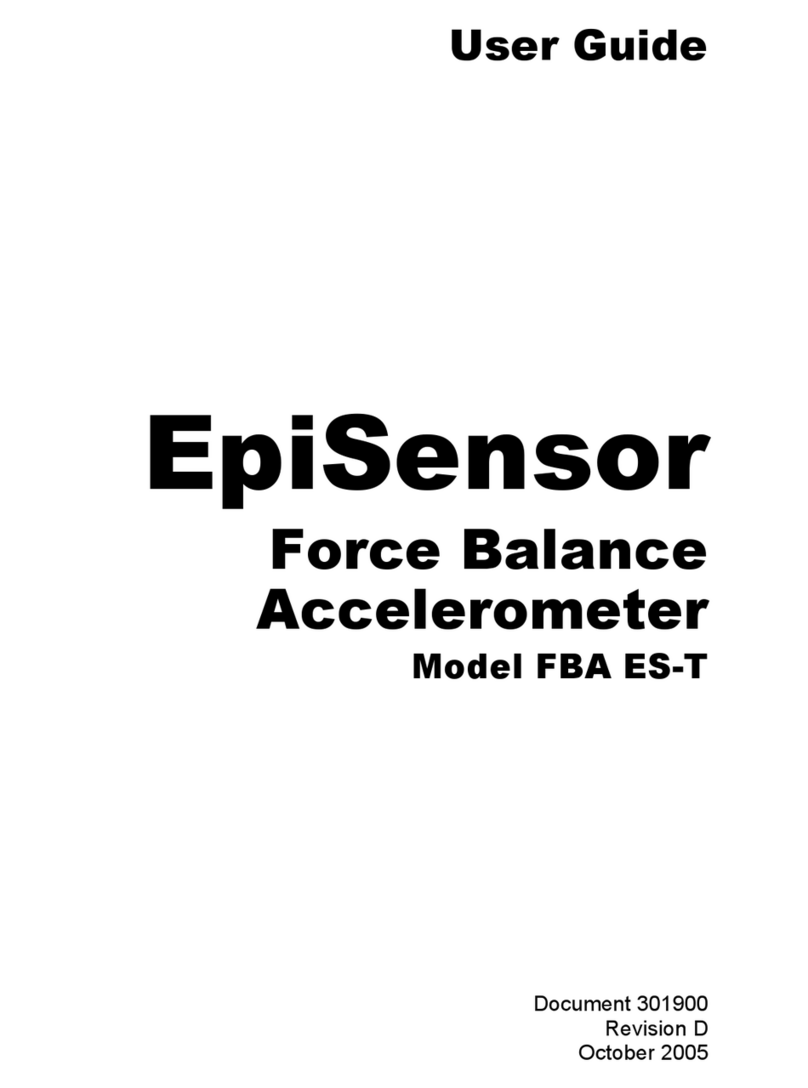Flow-tronic Raven-Eye User manual

Installation & Operation Manual
Open Channel Non-Contact
RADAR Flow Meter
V1.1, September 2013
Rue J.H. Cool 19a | B-4840 Welkenraedt | Tel.: +32 (0)87 899 799 | Fax: +32 (0)87 899 790 | E-mail: info@flow-tronic.com | www.flow-tronic.com


Rue J.H. Cool 19a | B-4840 Welkenraedt | BELGIUM
Tel. : +32 (0)87 899 799 | Fax : +32 (0)87 899 790
E-mail : info@flow-tronic.com | www.flow-tronic.com
-1 -
CONTENTS
1SPECIFICATIONS - 3 -
2GENERAL INFORMATION - 5 -
2.1 SAFETY INFORMATION - 5-
2.1.1 SAFETY SYMBOLS AND WARNINGS - 5-
2.1.2 PRECAUTIONARY LABELS - 5-
2.1.3 CONFINED SPACE PRECAUTIONS - 6-
2.1.4 R&TTE REGULATIONS - 6-
2.2 PRODUCT OVERVIEW - 7-
2.2.1 THEORY OF OPERATION - 8-
3INSTALLATION - 9 -
3.1 UNPACK THE INSTRUMENT - 9-
3.2 MECHANICAL INSTALLATION - 10 -
3.2.1 SITE LOCATION GUIDELINES - 10 -
3.2.2 SENSOR INSTALLATION - 12 -
3.2.2.1 INSTALL THE MOUNTING HARDWARE ON THE WALL - 13 -
3.2.2.2 ATTACH THE SENSOR TO THE MOUNTING HARDWARE- 14 -
3.2.2.3 ALIGN THE SENSOR VERTICALLY –RAVEN-EYE®WITHOUT ATTACHED LEVEL SENSOR - 16 -
3.2.2.4 ATTACH THE LEVEL SENSOR - 17 -
3.2.2.5 ALIGN THE SENSOR VERTICALLY –RAVEN-EYE®WITH ATTACHED LEVEL SENSOR - 17 -
3.2.2.6 ALIGN THE SENSOR HORIZONTALLY - 19 -
3.2.2.7 MAKE A FINAL ALIGNMENT CHECK - 19 -
3.2.2.8 MEASURE THE SENSOR OFFSET - 20 -
3.2.2.9 SENSOR OFFSET CALCULATION - 21 -
3.2.3 MEASURE THE PIPE DIAMETER - 22 -
3.3 ELECTRICAL CONNECTIONS - 23 -
3.3.1 ELECTROSTATIC DISCHARGE (ESD) CONSIDERATIONS - 23 -
3.3.2 WIRING - 23 -
4OPERATION - 24 -
4.1 UNI-TRANS - 24 -
4.2 RTQ-LOGGER SERIES - 24 -
4.3 MODBUS ASCII - 24 -
4.3.1 HOW DOES IT WORK? - 24 -
4.3.2 PARAMETERS - 25 -
4.3.3 MEASUREMENT DATA „READ ONLY“ - 25 -
4.3.4 LEVEL INPUT „READ &WRITE“ - 25 -

Rue J.H. Cool 19a | B-4840 Welkenraedt | BELGIUM
Tel. : +32 (0)87 899 799 | Fax : +32 (0)87 899 790
E-mail : info@flow-tronic.com | www.flow-tronic.com
-2 -
5MAINTENANCE - 26 -
5.1 PREVENTIVE MAINTENANCE- 26 -
5.2 CLEANING THE INSTRUMENT - 27 -
5.3 CABLE REPLACEMENT PROCEDURE - 27 -
6REPLACEMENT PARTS AND ACCESSORIES - 28 -
7CONTACT INFORMATION - 28 -
7.1 FOR BELGIUM AND LUXEMBOURG - 28 -
7.2 OUTSIDE BELGIUM AND LUXEMBOURG - 28 -
7.3 TECHNICAL SUPPORT - 28 -
7.4 REPAIR SERVICE - 28 -
APPENDIX - 29 -
APP.1FLOW-TRONIC CUSTOMER SERVICE DEPARTMENT REGISTRATION FORM - 29 -
WARRANTY STATEMENT - 30 -
Copyright © 1989-2013 Flow-Tronic S.A. All printed material should not be changed or altered without permission
of Flow-Tronic S.A. Any published technical data and instructions are subject to change without notice. Contact
your Flow-Tronic representative for current technical data and instructions.
Rue J.H. Cool 19a B-4840 Welkenraedt BELGIUM
Tel. : +32 (0)87 899 799 Fax : +32 (0)87 899 790
E-mail: info@flow-tronic.com www.flow-tronic.com

Rue J.H. Cool 19a | B-4840 Welkenraedt | BELGIUM
Tel. : +32 (0)87 899 799 | Fax : +32 (0)87 899 790
E-mail : info@flow-tronic.com | www.flow-tronic.com
-3 -
1Specifications
Specifications are subject to change without notice
RAVEN-EYE®
Dimensions (W x L x D)
140 x 422 x 183 mm, without cable and mounting hardware
Weight
3,85 kg, without cable and mounting hardware
Enclosure
IP68 waterproof rating, polyurethane (PU)
Operating temperature -20 to 50 °C
Storage temperature -30 to 60 °C
Power requirements Supplied by UNI-TRANS, RTQ-Logger Series or any 4.8 to 24 VDC power
supply
Interconnecting cable (disconnect at
both sensor and logger ends)
Polyurethane, 8 mm diameter
IP68 < 1bar
Standard length: 10 m ; maximum length: 300 m
Level measurement
Standard Range ultrasonic level sensor (range: 1,75 m) attached to the sensor
using a mounting hardware
Accuracy: 0,3%
Temperature error: max. 0,04%/K
Standard Range ultrasonic level sensor (range: 5,75 m) attached to the sensor
using a mounting hardware
Accuracy: 0,2%
Temperature error: max. 0,04%/K
External 4-20 mA loop powered level sensor with correct electrical parameters to
be connected to the UNI-TRANS.
Communication RS-485 with proprietary protocol for use with UNI-TRANS or RTQ-Logger Series
RS-485 with serial MODBUS ASCII slave open protocol for use with PLCs
Output 1 passive analog 4-20 mA (configurable for raw surface velocity or analyzed
surface velocity)
Velocity measurement
Method: Radar
Range: ±15 m/s to ±10 m/s (bi-directional)
Frequency Range: 24.075 to 24.175 GHz, <100 mW (EIRP) max.
Accuracy: ±0.5% ±0.02 m/s (based on sensed surface velocity)
Certification
The RAVEN-EYE®transmitter is certified to the following requirements:
- Frequency: 24,125 GHz - Doppler pulse
CE Directives EMC, R&TTE
Use of this device is subject to the following conditions:
1 There are no used serviceable items inside this device.
2 The user must install this device in accordance with the supplied installation
instructions and must not modify the device in any manner whatsoever.
3 Any service involving the transmitter must only be performed by
FLOW-TRONIC S.A. or authorized trained personal.
4 The user must ensure that no one is within 20 cm of the face of the radar
transmitter when operating.
Approvals R&TTE Directive 1999/5/EC
EN 300 440-1 V1.6.1 EMC / ERM 1-40 Ghz Radios : Part 1
EN 300 440-2 V1.4.1 EMC / ERM 1-40 Ghz Radios : Part 2

Rue J.H. Cool 19a | B-4840 Welkenraedt | BELGIUM
Tel. : +32 (0)87 899 799 | Fax : +32 (0)87 899 790
E-mail : info@flow-tronic.com | www.flow-tronic.com
-4 -
Flow measurement
Method Based on continuity equation Q = V*A calculated by logger or flow monitor
Accuracy ± 5% of reading typical where flow is in a channel with uniform flow conditions
and is not surcharged, ±1% full scale max.

Rue J.H. Cool 19a | B-4840 Welkenraedt | BELGIUM
Tel. : +32 (0)87 899 799 | Fax : +32 (0)87 899 790
E-mail : info@flow-tronic.com | www.flow-tronic.com
-5 -
2General Information
2.1 Safety information
Please read this entire manual before unpacking, setting up, or operating this equipment. Pay attention to all danger
and caution statements.Failure to do so could result in serious injury to the operator or damage to the equipment.
To ensure that the protection provided by this equipment is not impaired, do not use or install this equipment in any
manner other than that specified in this manual.
2.1.1 Safety Symbols And Warnings
Throughout this manual are safety warning and caution information boxes. Each warning and caution box will be
identified by a large symbol indicating the type of information contained in the box. The symbols are explained
below:
DANGER
Indicates a potentially or imminently hazardous situation which, if not avoided, will result in
death or serious injury.
WARNING
Indicates a potentially or imminently hazardous situation which, if not avoided, could
result in death or serious injury.
CAUTION
Indicates a potentially hazardous situation that may result in minor or moderate injury.
Important Note: Indicates a situation which, if not avoided, may cause damage to the
instrument. Information that requires special emphasis.
Note: Information that supplements points in the main text.
2.1.2 Precautionary labels
This is the safety alert symbol. Obey all safety messages that follow this symbol to avoid potential injury. If on
the instrument, refer to the instruction manual for operation or safety information.
Electrical equipment marked with this symbol may not be disposed of in European public disposal systems
after
12 August of 2005. In conformity with European local and national regulations (EU Directive 2002/96/EC),
European electrical equipment users must now return old or end-of life equipment to the Producer for
disposal at no charge to the user.
Note: For return for recycling, please contact the equipment producer or supplier for instructions on how to
return end-of-life equipment, producer-supplied electrical accessories, and all auxiliary items for proper
disposal.
This symbol, when noted on a product enclosure or barrier, indicates that a risk of electrical shock and/or
electrocution exists.
This symbol, when noted on the product, identifies the location of the connection for Protective Earth
(ground).
This symbol, when noted on the product, identifies the location of a fuse or current limiting device.
This symbol, when noted on the product, indicated the presence of devices sensitive to Electro-static
Discharge
(ESD) and indicated that care must be taken to prevent damage with the equipment.

Rue J.H. Cool 19a | B-4840 Welkenraedt | BELGIUM
Tel. : +32 (0)87 899 799 | Fax : +32 (0)87 899 790
E-mail : info@flow-tronic.com | www.flow-tronic.com
-6 -
2.1.3 Confined space precautions
DANGER
Confined space entry. Training in pre-entry testing, ventilation, entry procedures, evacuation/rescue
procedures and safety work practices is necessary before entering confined spaces.
Important Note: The following information is provided to guide users of RAVEN-EYE®Sensors on the dangers and
risks associated with entry into confined spaces.
Definition of a confined space:
A confined space is any location or enclosure that presents or has the immediate potential to present one or more
of the following conditions:
An atmosphere with less than 19.5% or greater than 23.5% oxygen and/or more than 10 ppm Hydrogen
Sulfide (H2S).
An atmosphere that may be flammable or explosive due to gases, vapors, mists, dusts or fibers.
Toxic materials which upon contact or inhalation, could result in injury, impairment of health or death.
Confined spaces are not designed for human occupancy. They have restricted entry and contain known or potential
hazards. Examples of confined spaces include manholes, stacks, pipes, vats, switch vaults, and other similar
locations.
Standard safety procedures must always be followed prior to entry into confined spaces and/or locations where
hazardous gases, vapors, mists, dusts or fibers may be present. Before entering any confined space check with
your employer for procedures related to confined space entry.
DANGER
Explosion hazard. Make sure your application is NOT an ATEX rated and does NOT require ATEX certified
equipment
2.1.4 R&TTE regulations
Use of this device is subject to the following conditions:
There are no used serviceable items in this device.
The user must install this device in accordance with the supplied installation instructions and must not modify the
device in any manner whatsoever.
Any service involving the transmitter must only be performed by FLOW-TRONIC S.A. or authorized trained
personal.
The user must ensure that no one is within 20 cm of the face of the radar transmitter when operating.

Rue J.H. Cool 19a | B-4840 Welkenraedt | BELGIUM
Tel. : +32 (0)87 899 799 | Fax : +32 (0)87 899 790
E-mail : info@flow-tronic.com | www.flow-tronic.com
-7 -
2.2 Product overview
The RAVEN-EYE®sensor measures the flow velocity in open channels using radar technology. The unit is
designed to withstand submersion during surcharge conditions. Optional level sensors provide the UNI-TRANS
monitor with the water level measurement during normal operation.
Figure 1: System
overview
1 RAVEN-EYE®Sensor 4 Mounting hardware (here: rotative handle)
2 Sensor cable 4 Level sensor mounting hardware
3 Level sensor
3
5
1
4
2

Rue J.H. Cool 19a | B-4840 Welkenraedt | BELGIUM
Tel. : +32 (0)87 899 799 | Fax : +32 (0)87 899 790
E-mail : info@flow-tronic.com | www.flow-tronic.com
-8 -
2.2.1 Theory of operation
The RAVEN-EYE®sensor is mounted above an open channel of water and measures the surface velocity. The
depth from water is measured by an optional associated level sensor. The two measurements are used to calculate
the flow rate using the continuity equation. The RAVEN-EYE®converts the surface velocity to average velocity by
analyzing surface velocity distribution using a self-learning technology that doesn’t require theoretical modules nor
site calibration. Then the water level and pipe size is converted to the fluid area. Multiplication of fluid area by
average velocity to obtain the flow rate.
Surface velocity measurement
The surface velocity of the water is measured using radar technology. A radar beam is transmitted from the sensor
to the water surface at the center of the channel. A portion of the signal is reflected back at a slightly different
frequency. The difference in frequency, known as the Doppler frequency, is directly proportional to the speed of the
flow. Proprietary Patent Pending velocity measurement algorithms are then used to calculate the average speed of
the flow stream.
Note: The radar velocity sensor does not operate under surcharge conditions.
Level measurement
The water level is measured using an ultrasonic pulse echo sensor. Two models are available, a standard range
1,75 m and a long range 5,75 m sensor. The sensors can be attached to the RAVEN-EYE®sensor body using
specific mounting hardware. For both sensors a sound pulse is sent to the water surface and a portion of the signal
is returned to the sensor. The transit time to the surface and back is used to calculate the distance from the water
surface to the sensor. The pipe diameter and sensor offset are used to convert the distance to water depth.
External 4-20 mA level sensors from other manufacturers can be used to be connected to the UNI-TRANS or any
other PLC or logger.
Flow calculations
The velocity and depth measurements are used with the channel shape and its dimensions to determine the flow
rate. The flow rate is calculated from the continuity equation (1):
(1) Flow rate = Average velocity × Area
where
Flow rate = volume of liquid that passes the sensor per unit time (e.g. 300 litres per second)
Average velocity = average velocity of the liquid, calculated using surface velocity measurements
and patent pending measurements algorithms
Area = cross-sectional area of the liquid in the channel, calculated using the channel
dimensions and depth measurement.

Rue J.H. Cool 19a | B-4840 Welkenraedt | BELGIUM
Tel. : +32 (0)87 899 799 | Fax : +32 (0)87 899 790
E-mail : info@flow-tronic.com | www.flow-tronic.com
-9 -
3Installation
3.1 Unpack the instrument
Before opening the shiping boxes, check them for any visible outside damage, and report the damages
immediately.
Carefully unpack the RAVEN-EYE®and its accessories from the shipping carton and inspect for any visible
damage. If an item is missing or damaged, please contact the manufacturer or local agent (refer to section 7 on
page- 28 -)
List of standard delivered items:
1. RAVEN-EYE®Sensor
2. Cable at specified length
3. Installation & operation manual
4. Extended warranty formular
5. USB communication cable (optional)
6. Standrd range or long range level sensor (optional)
7. Permanent or one-time entry sensor mounting hardware (optional)
8. Mounting hardware for ultrasonic standard range or long range sensor (optional)

Rue J.H. Cool 19a | B-4840 Welkenraedt | BELGIUM
Tel. : +32 (0)87 899 799 | Fax : +32 (0)87 899 790
E-mail : info@flow-tronic.com | www.flow-tronic.com
-10 -
3.2 Mechanical installation
3.2.1 Site location guidelines
For best accuracy, install the sensor where the flow is not turbulent. An ideal location is in a long, straight channel or
pipe. Outfalls, vertical drops, baffles, curves or junctions cause the velocity profile to become distorted.
Where there are outfalls, vertical drops, baffles, curves or junctions, install the sensor upstream or downstream as
shown in Figure 2 and Figure 3. For upstream locations, install the sensor at a distance that is at least five times the
pipe diameter or maximum fluid level. For downstream locations, install the sensor at a distance that is at least ten
times the pipe diameter or maximum fluid level.
If the location contains a junction and the flow in one pipe is muchhigher, install the sensor on the wall near the
lower flow pipe.
Figure 2: Sensor location near an outfall, vertical drop or baffle
1 Acceptable upstream sensor location 5 Distance downstream: 10 x pipe diameter
2 Outfall 6 Vertical drop
3 Distance upstream: 5 x maximum level 7 Baffle
4 Acceptable downstream sensor location
3 5
3 5
41 6
4
7
1
2
3
1

Rue J.H. Cool 19a | B-4840 Welkenraedt | BELGIUM
Tel. : +32 (0)87 899 799 | Fax : +32 (0)87 899 790
E-mail : info@flow-tronic.com | www.flow-tronic.com
-11 -
Figure 3: Sensor location near a curve, elbow or
junction
1 Acceptable upstream sensor location 3 Distance downstream: 10 x pipe diameter
2 Acceptable downstream sensor location 4 Distance upstream: 5 x pipe diameter
2
3
1
4
1
4
4
3
1
4
1 2
3
2
1
4
3 2
4
1

Rue J.H. Cool 19a | B-4840 Welkenraedt | BELGIUM
Tel. : +32 (0)87 899 799 | Fax : +32 (0)87 899 790
E-mail : info@flow-tronic.com | www.flow-tronic.com
-12 -
3.2.2 Sensor installation
CAUTION
Potential hearing loss risk. Hearing protection required. The level transducer emits ultrasonic sound
energy when powered. Ear protection must be worn when working within 1 meter of this device. Do
not point the transducer output towards ears during installation, calibration and maintenance.
Mount the RAVEN-EYE®sensor above the open channel on the wall of the manhole.
The RAVEN-EYE®sensor dimensions are shown in Figure 4 and Figure 5.
Figure 4: RAVEN-EYE®sensor
dimensions side view as installed
Figure 5: RAVEN-EYE®sensor dimensions top view as installed
300 mm
400 mm
140 mm

Rue J.H. Cool 19a | B-4840 Welkenraedt | BELGIUM
Tel. : +32 (0)87 899 799 | Fax : +32 (0)87 899 790
E-mail : info@flow-tronic.com | www.flow-tronic.com
-13 -
Figure 6: RAVEN-EYE®sensor dimensions top view with level sensor as installed
3.2.2.1 Install the mounting hardware on the wall
Sensor location guidelines
Review the following guidelines to find the best location for the sensor.
Examine the upstream and downstream flow characteristics. Use a mirror if necessary. Install the sensor
above the water where the flow is steady. Do not install the sensor where there are standing waves, pools
or objects or materials that can disrupt the flow profile.
If the upstream flow characteristics are acceptable, install the sensor on the upstream wall of the manhole
with the sensor pointing upstream. This location will make sure that the measured flow is the same as the
flow in the pipe and that the sensor cable points away from the wall.
Install the sensor away from the sides of the pipe and in the very center of the flow where the fluid is at
the maximum depth.
Install the sensor in a location that is accessible for maintenance.
Prerequisites
Permanent or one-time entry mounting hardware
Material needed: Fixings, washers and screws from the correct size
Tools needed: mirror, ruler or tape measure, marker, battery operated power drill, wrench.
Procedure
Complete the steps to install the mounting hardware on the wall of the manhole above the flow. Be sure to follow all
codes and/or directives that are relevant to the location (refer to section 3.2.1 on page - 10 -).
1. Make a mark on the wall 400 mm above the crown of the pipe. The wall bracket will be installed centered
on this mark.
2. Make sure that when the sensor is in position, the radar beam will not be blocked by the wall or channel.
Refer to Figure 9 or Figure 11.
3. Position the wall mount bracket centered around this mark.
4. Attach the brackets to the wall using anchors and screws.
5. Connect the rest of the mounting hardware to the wall bracket.
140 mm
550 mm

Rue J.H. Cool 19a | B-4840 Welkenraedt | BELGIUM
Tel. : +32 (0)87 899 799 | Fax : +32 (0)87 899 790
E-mail : info@flow-tronic.com | www.flow-tronic.com
-14 -
Figure 7: Wall
installation
1 Distance from crown of pipe to wall bracket
3.2.2.2 Attach the sensor to the mounting hardware
The sensor is equipped with 4 threads (M5) to be attached to the mounting hardware. Attach the rotative handle or
the ball mount to the sensor. The sensor can be removed from the frame and installed without entering the
manhole when installed with the one-time entry mounting hardware.
Procedure
1. Make sure that the cable is tightly connected to the sensor.
2. Locate the 4 threads on the sensor forseen to attach the ball mount or the rotative handle.
3. Attach the ball mount or the rotative handle to the sensor using a screwdriver and the 4 M5 screws
delivered with the hardware.
4. Loosen the wing nut from the ball mount of the mounting hardware.
5. Insert the ball mount from the sensor and thighten the wing nut so that the sensor stays attached to the
mounting hardware.

Rue J.H. Cool 19a | B-4840 Welkenraedt | BELGIUM
Tel. : +32 (0)87 899 799 | Fax : +32 (0)87 899 790
E-mail : info@flow-tronic.com | www.flow-tronic.com
-15 -
Figure 8: Assembling the mounting hardware
1 Ball mount 3 Threads for mounting hardware attachment
2 Wing nut
2
1
3

Rue J.H. Cool 19a | B-4840 Welkenraedt | BELGIUM
Tel. : +32 (0)87 899 799 | Fax : +32 (0)87 899 790
E-mail : info@flow-tronic.com | www.flow-tronic.com
-16 -
3.2.2.3 Align the sensor vertically – RAVEN-EYE®without attached level sensor
The sensor must be aligned vertically to make sure that the sensor is above the flow and that the radar beam will
not be blocked by the wall or pipe (Figure 9).
Procedure
1. Make an estimate of where a line that extends from the top of the radar lens perpendicular to where the
lens will point (Figure 9).
2. Loosen the wing nut on the ball mount hardware and position the frame so that the radar beam will point
below the crown of the pipe by at least 25 mm (Figure 9). It may be necessary to install the 200 mm or
the 300 mm (optional) spacer to position the RAVEN-EYE®farther from the wall.
3. Tighten the wing nut and make sure that the radar beam is not blocked by the wall or pipe. If the beam is
blocked, move the frame further away from the wall using the 200 mm or the 300 mm (optional) spacer or
lower the frame.
Figure 9:
Vertical alignment of the RAVEN-EYE
®
sensor
1 Spacer 3 Line that extends from the top of the radar lens
perpendicular to where the lens will point
2 Distance fromcrown ofpipe to ball mount 4 Wing nut
1
3
25 mm
2
4

Rue J.H. Cool 19a | B-4840 Welkenraedt | BELGIUM
Tel. : +32 (0)87 899 799 | Fax : +32 (0)87 899 790
E-mail : info@flow-tronic.com | www.flow-tronic.com
-17 -
3.2.2.4 Attach the level sensor
Procedure
1. Locate the 4 threads to attach the level sensor.
2. Locate the level sensor support and the corresponding screws to attach the hardware.
3. Attach the level sensor support using a screwdriver and the corresponding screws.
4. Attach the level sensor to the level sensor support hardware using the delivered nut.
Figure 10: Level sensor attachment
1 Threads for level sensor support attachment 3 Screws to attach the level sensor support
2 Level sensor support 4 Nut for level sensor attachment
3.2.2.5 Align the sensor vertically – RAVEN-EYE®with attached level sensor
Prerequisites
Attach the level sensor support to the RAVEN-EYE®.
Tighten the level sensor to the level sensor support.
The sensor must be aligned vertically to make sure that the sensor is above the flow and that the radar beam will
not be blocked by the wall or pipe (Figure 11).
Procedure
1. Make an estimate of where a line that extends from the top of the radar lens perpendicular to where the
lens will point (Figure 11).
1
2
3
4

Rue J.H. Cool 19a | B-4840 Welkenraedt | BELGIUM
Tel. : +32 (0)87 899 799 | Fax : +32 (0)87 899 790
E-mail : info@flow-tronic.com | www.flow-tronic.com
-18 -
2. Loosen the wing nut on the ball mount hardware and position the frame so that the radar beam will point
below the crown of the pipe by at least 25 mm (Figure 11). It may be necessary to install the 200 mm or
the 300 mm (optional) spacer to position the RAVEN-EYE®farther from the wall.
3. Tighten the wing nut and make sure that the radar beam is not blocked by the wall or pipe. If the beam is
blocked, move the frame further away from the wall using the 200 mm or the 300 mm (optional) spacer or
lower the frame.
Figure 11:
Vertical alignment of the RAVEN-EYE
®
sensor with attached level sensor
1 Spacer 4 Level sensor (ULS-02 or ULS-06)
2 Distance fromcrown ofpipe to ball mount 5 Level sensor offset
3 Line that extends from the top of the radar lens
perpendicular to where the lens will point 6 Distance fromcrown ofpipe to tipof level sensor
1
3
25 mm
4
5
2
6
Table of contents
